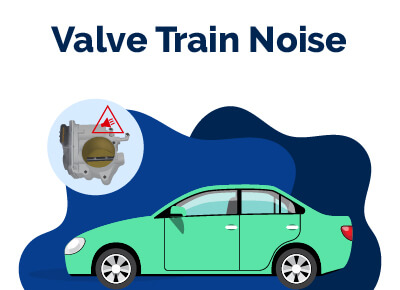Valve Train Noise (Key Causes and Fixes)
July 26, 2023


Chris is Head of Content for FindTheBestCarPrice and is based out of Philadelphia, PA. As a seasoned automotive industry analyst and car enthusiast, he ensures the highest level of quality across all our content and curates our picks for the best deals each month.
Chris studied information systems and marketing at Drexel University and writes about a wide range of topics ranging from car buying tips to troubleshooting common mechanical issues.
When he’s not thinking about cars, he likes to stay in with his dog and make an “attempt” to finish a crossword puzzle (he’s not quite at the Saturday/Sunday level…yet). As a former cheesemonger, Chris still has a “sharp” passion for all things cheese, and his fridge is always loaded with it!
Chris also has a passion for things that go fast, and drones are no exception. He spends some of his time writing for Dronesourced.
The valve train comprises various components, including valves, rocker arms, pushrods, lifters, and camshafts. The collective arrangement of these parts ensures the optimal balance of the air/fuel mixture ratio as it enters the combustion engine.
In the event of a malfunction in the valve train or any of its constituent elements, audible valve train noises may arise, characterized by a clicking or clattering sound.
While the valve train may not be a term commonly used by laypeople, it is often implicated in commonplace noises and knocks that prompt the vehicle owner to seek assistance at local automotive service centers.
Let’s look at what causes the valve train noise, its symptoms, and how to fix it.
Table of Contents
What is a Valve Train?
A valve train is a complex mechanical system that governs the operation of the intake and exhaust valves in an internal combustion engine.
The intake valves regulate the inflow of air/fuel mixture (or air in the case of direct-injected engines) into the combustion chamber. In contrast, the exhaust valves control the outflow of spent exhaust gases after combustion.
1. Layout
The arrangement of the valvetrain is largely contingent upon the location of the camshaft, and there are several standard configurations for piston engines, ranging from older to newer designs:
Flathead engine
The camshaft and valves are situated in the engine block below the combustion chamber in this configuration.
Overhead valve engine
The camshaft remains in the block, but the valves are positioned in the cylinder head above the combustion chamber.
Overhead camshaft engine
The valves and camshaft(s) are located in the cylinder head above the combustion chamber in this setup.
2. Components
The valvetrain encompasses a variety of components that work in concert to translate the rotational motion of the camshaft into the opening and closing of the intake and exhaust valves.
These components, listed in sequential order from the crankshaft to the valves, typically include:
Camshaft
The camshaft(s) regulates the valve opening, which features specifically shaped lobes on a rotating shaft.
The crankshaft drives the camshaft and, in a four-stroke engine, rotates at half the speed of the crankshaft.
Motion is usually transferred from the crankshaft to the camshaft using a rubber timing belt, a metallic timing chain, or a set of gears.
Pushrod
Pushrods are elongated and slender metal rods employed in overhead valve engines to transmit motion from the camshaft to the valves (located in the cylinder head).
The lower end of a pushrod is equipped with a lifter, upon which the camshaft makes contact.
The camshaft lobe raises the lifter, which in turn moves the pushrod. The upper end of the pushrod then acts on the rocker's arm, causing the valve to open.
Rocker Arm / Finger / Bucket Tappet
A rocker arm, finger, or bucket tappet can act on the valves depending on the specific design.
Overhead valve engines utilize rocker arms, which are indirectly actuated from below (via the pushrods) by the cam lobes.
On the other hand, overhead camshaft engines employ fingers or bucket tappets that are directly actuated from above by the cam lobes.
Valves
Most modern engines employ poppet valves, although sleeve, slide, and rotary valves have been utilized in some instances.
Poppet valves are typically opened by the camshaft lobe or rocker's arm and closed by a coiled spring known as a valve spring.
Valve Float
Valve float can occur when the valve spring cannot effectively control the valvetrain's inertia at high engine speeds.
Causes and Fixes of Valve Train Noises
The prevailing causes are clearance concerns, hydraulic lifter malfunctions, and worn rocker arms.
1. Damaged Rocker Arm
If you perceive a rattling or clattering sound upon starting the engine, it could be attributed to a deteriorated rocker arm.
While this occurrence is infrequent, it is advisable to inspect the rocker arm if a considerable amount of time has elapsed.
It is important to note that a faulty rocker arm does not pose any imminent danger to the engine but manifests as engine noise. The primary cause of a worn rocker arm is often an inadequate lubrication system.
To identify an issue with the rocker's arm, you can use a mechanic's stethoscope or a rubber hose to pinpoint the noisy rocker arm, following the earlier steps.
Additionally, inspect the rocker arm for rough spots where it meets the valve, which may indicate a problem.
If any of these symptoms are encountered, it signifies a problem with the rocker arm, and improving the lubrication can help prevent further damage.
Note: In some cases, valve train noise may be caused by contaminated oil. Replacing the oil and filter could resolve the issue.
Furthermore, it is also plausible that a malfunctioning valve spring may be the underlying cause. Attempting to change the valve spring with a wrench could resolve the issue, and if successful, further attention to the spring may be necessary.
Regularly acquainting oneself with maintenance tips can be a proactive approach to staying abreast of potential automotive issues and their solutions.
2. Problems With the Hydraulic Lifter
The hydraulic lifter constitutes an integral component of the valve train assembly. When the lifter becomes worn or fails to function optimally, it generates an audible clattering noise.
However, before delving into the possibility of a faulty lifter, it is prudent to thoroughly inspect other components, such as rocker arms, pushrods, and springs.
Before embarking on a lifter examination, ensure that you have taken the following measures:
Verify the oil level is within the appropriate range. Assess the condition of the oil. Test the valve adjustment for accuracy.
When the lifter sticks, employing a detergent additive for the engine oil can resolve the issue. However, a lifter replacement may be required if the lifter persists in malfunctioning despite these efforts.
To effectuate a lifter replacement, commence by removing the valve cover and identifying the faulty lifter.
If a mechanic's stethoscope is available, it can aid in pinpointing the problematic lifter. Alternatively, a rubber hose can serve as a viable substitute. Follow the subsequent steps:
- Remove the valve cover.
- Set the parking brake and engage Neutral or Park mode for the transmission.
- Start the engine and allow it to idle
- Place one end of the rubber hose against your ear and the other over each valve.
- The malfunctioning lifter will emit a distinctly louder sound when the hose is placed over it, enabling identification for further action.
3. Clearance
The intricate process of valve operation entails the opening and closing of valves in tandem with the engine's rotational motion.
Notably, the frequency of this cycle corresponds to a rate of one valve opening and closing for every two engine revolutions.
Such rapid valve movement transpires over minimal distances, facilitated by adjusters that support the precise functioning of the valves.
Over time, however, these components may undergo wear and tear, increasing distances between the valves and their corresponding adjusters.
Consequently, this leads to an augmented clearance, manifesting as an audible ticking sound. This particular noise is prevalent in the valve train, but it can be remedied by adjusting the rocker arms or installing new shims to restore optimal clearances.
In engines featuring a pushrod-style design with solid lifters, it is imperative to maintain the pristine condition of the lifters.
The presence of oil deposits or dirt on the lifters can generate undesirable engine noises, underscoring the significance of regular cleaning and maintenance of these crucial components.
Best Car Deals by Category
Frequently Asked Questions
What are the common causes of valve train noises in an engine?
Common causes of valve train noises include worn rocker arms, faulty hydraulic lifters, poor lubrication system, dirty oil, misadjusted valves, and worn valve springs.
How can I identify which valve train component is causing the noise?
To identify the component causing the noise, you can use a mechanic's stethoscope or a rubber hose to pinpoint the source of the noise by listening for louder sounds at different points along the valve train, such as rocker arms, pushrods, or lifters.
Can valve train noises harm my engine?
While valve train noises are generally not harmful to the engine, they may indicate underlying issues that could cause damage if not addressed promptly, such as worn or damaged components that may require replacement or adjustment.
Can I fix valve train noises on my own?
Depending on the cause and severity of the valve train noise, some issues may be resolved by DIY adjustments, such as adjusting the rocker arms or replacing worn shims. However, it is recommended to seek professional assistance from a qualified mechanic for more complex issues.
How often should I inspect and maintain my engine's valve train to prevent noises?
Regular maintenance and inspection of the engine's valve train are crucial to prevent noises and ensure optimal performance. It is recommended to follow the manufacturer's recommended maintenance schedule, which may vary depending on the vehicle's make, model, and usage.
Are there any preventive measures to minimize valve train noises?
Yes, some preventive measures include maintaining proper oil levels and oil condition, using detergent additives in the engine oil to prevent lifter sticking, ensuring correct valve adjustments, and replacing worn components, such as rocker arms or valve springs, promptly to prevent valve train noises from occurring.
Posted in Car Buying Tips, Car Troubleshooting |




